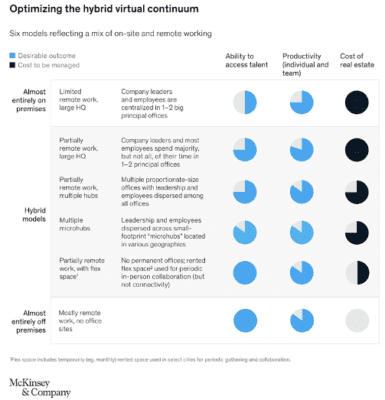How Can You Make Virtual Work Effective?
When it comes to the wide world of virtual work, one certainty that you’re likely to encounter is that definitions of the term can be a little hazy. This is due to the mass experimentation of businesses, as their decision-makers explore how to embrace virtual teams. Alongside rapidly developing technology, they continue to open the door to new possibilities.
Another reason why definitions can be confusing is that virtual working jobs fall under a wide umbrella. These include; ‘virtual’, ‘remote’, ‘at-home’, ‘online’, ‘distributed’, and ‘telecommute’ roles, among many other interpretations.
Many recruiters use these terms interchangeably. But, there are some important distinctions that can be made to differentiate virtual work from other remote approaches. For businesses hoping to instil a collaborative virtual workspace for their employees, these distinctions can be pivotal.
With this in mind, let’s take a deeper look at what virtual work means. Also, why does it hold many advantages for businesses looking to operate in a more remote manner?
What is Meant by Virtual Working?
The term ‘virtual’ refers to anything that can be digitally replicated. Through the use of software, virtual work is categorised as something that has been digitally converted from the physical world into an online environment.
With this in mind, virtual or online work directly refers to work that can be completed in a virtual workplace. This means that virtual work can be undertaken in an environment that isn’t specifically located in one single physical space. Instead, it is hosted on a virtual platform.
Oftentimes, these virtual workplaces can be communal places where many colleagues can interact with one another remotely. This is despite being far away from one another, even in other countries.
For a virtual workplace to be functional for businesses, they usually incorporate a vast combination of distributed employees, employers, technological hardware, software, and different virtual processes.
Why is it Called Virtual Work?

It’s called virtual work because, essentially, the work that employees will complete will be done in a fully virtual environment, via the use of online services and platforms.
Technological advancements in remote tools like Monday, Slack, and Google Drive mean that it’s far easier for workers to complete tasks, upload documents, and collaborate with colleagues all from remote locations.
Virtual workspace examples can include completing tasks at home, in a public space, or at a coffee shop. Just about anywhere in which an employee can access the internet.
What is a Virtual Job Called?
Virtual jobs are also categorised as ‘telecommuting’, ‘remote work’, ‘home-based work’, and ‘WFH’ among other terms and acronyms.
Essentially, virtual jobs refer to just about any line of work that can be completed digitally from a remote location. This means that workers will collaborate with their colleagues online via instant messaging platforms, video conferencing, and virtual meeting spaces.
So there are many terms popularly used in an interchangeable fashion to describe virtual work. But, there are some differences between terms like virtual work and remote work.
What is the Difference Between Working Remotely and Working Virtually?
Both remote and virtual working come with no obligations for employees to work in a single physical environment or office to complete their tasks. Despite this, there are some distinctions between virtual and remote working that it’s important to address. Particularly when it comes to matters of management.
Virtual Working
Virtual teams are typically composed of multiple colleagues collaborating on the same project but who are reporting to different team leaders.
This means that virtual team employees are generally distributed. But their team leaders are based within the same physical location, with many virtual team leaders reporting directly to a lead manager.
Because virtual team setups are distributed across a number of leaders, decisions aren’t dependent on one single person.
Remote Working
Unlike virtual working, remote teams generally consist of a number of employees working together on the same project, with the same overall objectives whilst working under the management of one single leader.
This means that the team leader retains full control over all of the operational aspects of a given project.
Remote teams can be heavily distributed, with many employees collaborating from different continents. Some team members may never meet in a physical environment, and managers could never meet their employees. However, this doesn’t mean that remote employees have to be far away from their company’s offices, and some can actually live relatively near their office–despite never setting foot inside.

(Image: Gallup)
When it comes to the future of out-of-office work, we can see that many businesses are still yet to agree how to approach projects of late. This is largely down to the disruption caused by the recent Covid-19 pandemic and the speed in which many companies were forced to embrace digital transformation.
With 62% of employees content with some form of coordinated hybrid approach and 38% intent on full autonomy, we’re likely to see both virtual working and remote solutions continue to grow in popularity over the course of the decade.
What are the Advantages of Virtual Working?
Some businesses may still be unsure of whether or not to press ahead with embracing virtual working. But, here are many advantages that can help to deliver better employee satisfaction and operational costs. Let’s take a look at five key advantages of virtual work:
1. Reduce Office Costs
For businesses of all sizes, the implementation of virtual workplaces like Slack and Microsoft Teams invariably help to lower overhead costs attached to the company.
Furthermore, virtual collaboration is set to be a far more sustainable solution over time. The Lee Group notes that one study found that 10 million employees based on an entirely remote basis would save 21 million barrels of oil per year. With the price of oil standing at $95.59 per barrel at the time of writing, this act alone would save more than $2 billion in oil costs per year.
Additionally, employers reap the benefits of implementing virtual workplaces by saving on the costs associated with running an office. In terms of office ownership or rent, downsizing or selling an office space can save thousands. Furthermore, the matter of powering an office, filling it with equipment and supplies is eliminated. Also, it’s not unusual for employees to work via their own PCs whilst using equipment they own. This means that in some cases equipment costs can be completely wiped from the budget.
2. Greater Employee Retention Rates
Businesses can also reap the benefits of advertising for job roles that are highly appealing to millennial workers, who currently hold the largest talent pool across a range of industries.

(Image: Hubble IQ)
As the chart above shows, some 70.6% of millennials have held a favourable opinion of remote work, alongside older generations of workers. This can be a useful tool in enabling employers to retain their talent better over time.
Furthermore, there is no need for relocation costs associated with moving offices. If an existing employee needs to move home, they’ll be able to continue working with virtually no friction throughout the moving process. This empowers businesses to hold far better retention rates. Additionally, it eliminates the need of finding a suitable replacement for every employee who leaves the company.
To support this thesis, Time Doctor reports that companies that hold some form of virtual work paradigm have recorded 25% lower turnover rates.
3. Excellent Scalability Options
When it comes to working in physical locations, business growth can come at a significant cost to operations. Increasing staff to accommodate more growth will often require upscaling into a larger office space. This could cause widespread disruption and incur more rental and real estate costs.
Fortunately for companies operating in virtual teams, it’s possible to scale up operations without having to worry about matters of square footage and increasing utility and supply costs.
4. Tap into a Greater Pool of Talent
Virtual teams also pave the way for businesses to tap into a greater pool of talent that extends way beyond their geographical location.
The possibilities of talent acquisition in the age of virtual workplaces are borderless. Both experts and specialists from entirely different continents can collaborate together on projects when hiring domestic talent could be a difficult or limited process.
Furthermore, the increased levels of knowledge sharing and innovation can be encouraged as distributed employees share their understanding of global and local markets as well as the best business practices from different perspectives.
5. Money-Saving Automation

The cost saving of distributed teams can also extend to the seamless integration of automation. By utilising virtual support, businesses undergoing digital transformation can take many cost elements out of traditionally office-based roles.
This doesn’t have to involve replacing existing employees. But the added automation in areas like customer service can offer an extra level of assistance to a company that’s undergoing scaling. Despite this, there are still positions that are integral to a company’s operations. These should be maintained within a functional organisation chart.
As a business embraces the potential of online operations, teams can be stretched further–and potentially with little time for training. By incorporating virtual platforms that distributed employees can gain insights from and build collaboration approaches using their data, it’s possible for companies to further optimise their operations online.
What are the Disadvantages of Virtual Working?
Naturally, it’s important for businesses to consider both sides of the coin when making such a significant decision like whether or not to embrace virtual working. With this in mind, let’s take a deeper look at some of the disadvantages that can arise from this approach:
1. The Lack of Face-to-Face Communication can be Difficult for Some Employees
For any business that’s intent on embracing virtual working, the lack of face-to-face communication and collaboration can be difficult for employees for a number of reasons.
Firstly, feelings of isolation can conjure challenging emotions for many remote employees. It’s essential for companies to factor negative emotions emerging from feelings of loneliness into their support programs.
Furthermore, without meeting colleagues in person, employees can maintain a much more formal and impersonal relationship with their team. Whilst this isn’t necessarily an issue, a lack of team camaraderie can lead to losses in employee motivation and morale.
Businesses looking to embrace virtual work will need to consider how employees can feel isolated from their teams. They will need to remedy this with more virtual bonding sessions. This can be lighthearted weekly meetings, online quizzes on Fridays, or even an extra-curricular film club via Zoom calls. This added element of social bonding can help to build better teamwork and a sense of belonging.
2. Software Costs can Impact Budgets
Successful operations within a virtual team depend upon the use of many different forms of communication software. This includes; instant messaging platforms, email services, video-conferencing platforms, and collaboration tools. There are also many more technologies that can help bring distributed teams together in a virtual environment.
Because no single tool can offer comprehensive support, businesses may find that the combined costs of adopting various technologies, maintaining them, and installing them throughout all employee computers can impact budgets. This is despite the fact that money will be saved on in-house costs.
3. Greater Security Risks
When it comes to some industries, it can be highly risky to store confidential data in remote settings. For companies working in an office, all sensitive documents will be stored on an internal server that’s likely to be more secure than other internet providers.

Because remote employees may be using their own personal computers to complete work whilst communicating through servers that may be less secure, there’s a far greater risk that confidential documents may fall into the wrong hands. This can make digital transformation towards virtual working environments for businesses operating in, say, the financial sector, healthcare, or any other industry that can hold private data much more complex to successfully manage.
How do You Work Effectively Virtually?
Communication is essential for teams that are committed to virtual working. For both large and small businesses alike, it’s imperative to adopt the right technology. This will make collaboration as seamless as possible for all parties.
By adopting the right technology, businesses can exchange information in a more efficient manner. This is whilst video conferencing platforms can enable team members to feel as though they’re in the same room as their colleagues. This is a vital tool in limiting feelings of isolation among a company’s workforce.
Virtual work conducted via email is unlikely to cut it when it comes to collaborating within teams. This is due to varied time zones and the difficulty of knowing when to expect a reply. However, introducing instant messaging for faster communication while retaining email chains to empower employees to write longer, more well thought out replies can be an effective way to introduce greater flexibility.
The Functional Structure
In addition to this, it’s essential that businesses embracing virtual work adopt a functional structure within the company. To ensure employees are working effectively virtually, it’s important to designate hours for team members to be online.
The beauty of remote work is that it can be largely flexible. But, having set schedules can be good for when managers want to schedule a meeting on short notice. It’s also beneficial for employees to be as accessible as possible for matters of collaboration and queries from workers within a virtual team.
To help maintain a sense of structure, it’s worth scheduling regular meetings to help employees to plan their weeks better.
What are the 7 Steps to Make a Strong Virtual Team?
Many businesses are embracing virtual work in a variety of different ways. But, there are seven steps that are commonly followed by a variety of firms seeking to foster conducive virtual environments:
- Establish virtual social spaces for employees.
- Embrace video collaboration wherever possible.
- Utilise remote collaboration tools.
- Build a coherent remote policy.
- Offer essential office supplies to staff.
- Ensure that support is on-hand for employees struggling in isolation.
- Be aware of the first signs of employees struggling with virtual work.
What Makes a Successful Virtual Environment?
Firstly, businesses need to understand their own operating models when looking at virtual working. Many companies have been forced to consider digital transformation in recent years. And they have done this without taking more of a ‘big picture’ approach to what their virtual workspace online will look like.

(Image: McKinsey)
Companies considering their options in fully embracing virtual working need to be aware that they also have many hybrid options still available to them. Even if they come with separate ramifications regarding cost, access to talent, and productivity these are still options.
Above all else, remote work demands that businesses set tangible objectives and goals for staff. This can help individuals to fully understand what’s expected of them even though there will be no manager on-hand to set tasks in a face-to-face environment.
Another practice for businesses is to ensure that employees remain engaged at all times. In virtual teams, this can be tricky. This is particularly if workers are operating in different time zones. But, having regular meetings, rewards for top performers, and a flow of extra-curricular participation invites for remote workers to form a sense of attachment to the company can go a long way.
The Future of Virtual Work
The beauty of virtual work is that the technology supporting it is still in its infancy. In the future, we can expect video conferencing, instant messaging, and other collaborative platforms to continue to grow in their levels of sophistication and quality of automation.
Businesses can also look to the seemingly infinite potential of the metaverse. This is set to offer functional virtual reality collaborative spaces for businesses to securely share data and hold immersive meetings for employees around the world.
For companies seeking to embrace digital transformation and forge a productive virtual working environment, it seems as though there’s no time like the present. Growing a digitally capable workforce today can help to lower expenses and foster a conducive virtual workplace that will continue to grow in the future.




